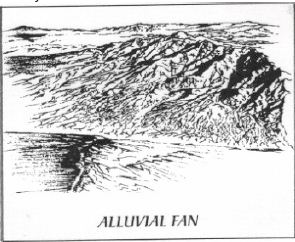نمایش نتیجه 1 تا 10 از 358 نتیجه یافت شده برای sand:
n: a large, sloping sedimentary deposit at the mouth of a canyon, laid down by intermittently flowing water, especially in arid climates, and composed of gravel and sand. The deposit tends to be coarse and unworked, with angular, poorly sorted grains in thin, overlapping sheets. A line of fans may eventually coalesce into an apron that grows broader and higher as the slopes above are eroded away.
land counterpart of a river delta. Characteristic of sediments that have been transported by a fast moving stream then dropped out of the flow as the stream velocity drops as it spreads out. Typical of zones of heavy water runoff such as found at the base
مخروط آبرفتی
ماسه ی آبرفتی
unconsolidated to well sorted to poorly sorted (gravel to sand sized) particles transported by water.
n: the pattern of minute projections from a metal surface produced by sandblasting, shot blasting, or chemical etching to enhance the adhesiveness of surface coatings.
the deviation angle (from vertical) at which a solid material will no longer fall down the pipe, but will begin to accumulate on the pipe wall. The angle of repose for dry, round sand is about 62o and for wet sand about 50o to 60o depending on size, shape
a negatively charged surfactant. Normally water wets sands.
n: Refers to eyeholes formed by mud desander in drilling operation.
the unobstructed opening size (diameter, length and width, or other shape factor).
n: The solid particle that can not pass the American NO.200 standard sieve, that is refered to the solid particle whose diameter is bigger that 74um.
a large, load supporting formation that may serve to reduce the total overburden load on a pay zone. These formations may cover hundreds of square miles over a basin. A second use is as a semi-stable structure of sand grains around a perforation or other
an empirical relationship between the formation resistivity, F, and porosity, , in which F=1/m, where the porosity exponent or cementing factor, m, is a constant for a particular formation. Typical m’s are 1.8 to 2.0 for consolidated sandstones and 1.3





